
The Internet has revolutionized how we do business. While it hasn’t completely replaced every offline business, almost all businesses have transitioned to online presence.
The reason is simple: Internet users have skyrocketed in the past few years, creating an increased demand there.
It is estimated that there will be 7 billion Internet users by 2028. People have started spending more time on social media and are pursuing new careers in blogging, content marketing, lead generation, and more.
This also explains why we’re seeing a surge in online business and digital marketing services.
But what does it mean for us?
To evaluate the evolving dynamics of new-age customers, we’ve set out to determine some exciting online business statistics and forecasts for 2024 and beyond.
Key Findings
- – Internet usage continues to grow rapidly, with over 5.18 billion (64.6 percent of the global population) users worldwide in 2023. This number is expected to reach 5.5-6 billion by 2024.
- – Asia has the highest % of Internet users at 67.4% (2022), while mobile is the fastest-growing segment. Mobile Internet usage will likely exceed 7.49 billion globally by 2024.
- – Retail e-commerce sales have grown from $5.2 trillion in 2021. However, the projections show e-commerce sales hitting $8.1 trillion by 2026. India is on top with a CAGR of 14.11% in 2023-2027.
- – Getting responses from prospects and engaging multiple decision-makers are top sales challenges. These will persist as buyers do more research before purchasing.
- – 50% of local mobile searches result in an in-store visit within a day. By 2024, over 60% of local searches will drive in-store traffic.
- Loyal customers are worth up to 10x more than new customers. However, retention has become even more important as acquisition costs rise.
- – 82% of people expect an immediate response to sales questions. Brands will need to prioritize real-time engagement and conversational commerce.
- – Content marketing generates 3x more leads at 62% lower cost versus outbound marketing. Content production will be a top investment for brands through 2024.
- – Email marketing delivers the highest ROI (122%) versus other channels. Email usage will hold steady despite growth in emerging channels.
Segmentation of Online Businesses With Predictions for 2024
1. Internet
The growth speed of Internet usage is mind-blowing. Global Internet users are expected to surpass 5.5 billion, acquiring 67.73% of the world population by 2024. Meanwhile, Asia will dominate, as half of its population is online.
Mobile has quickly become the fastest-growing segment, and mobile Internet users are anticipated to grow equally in the next few years.
For digital businesses, the takeaway is evident – optimize for mobile to keep up with the competitive landscape or get left behind! Here are some statistics showing the Internet’s importance in the coming years.
- – Internet usage continues to grow rapidly, with over 5.18 billion global users in 2023. This number could exceed 5.5 billion by 2024 and 6 billion by 2030.
- – Mobile is dominating, with over 7.26 billion people accessing the Internet via phones and tablets by 2022. It will likely increase to 7.49 billion by 2025.
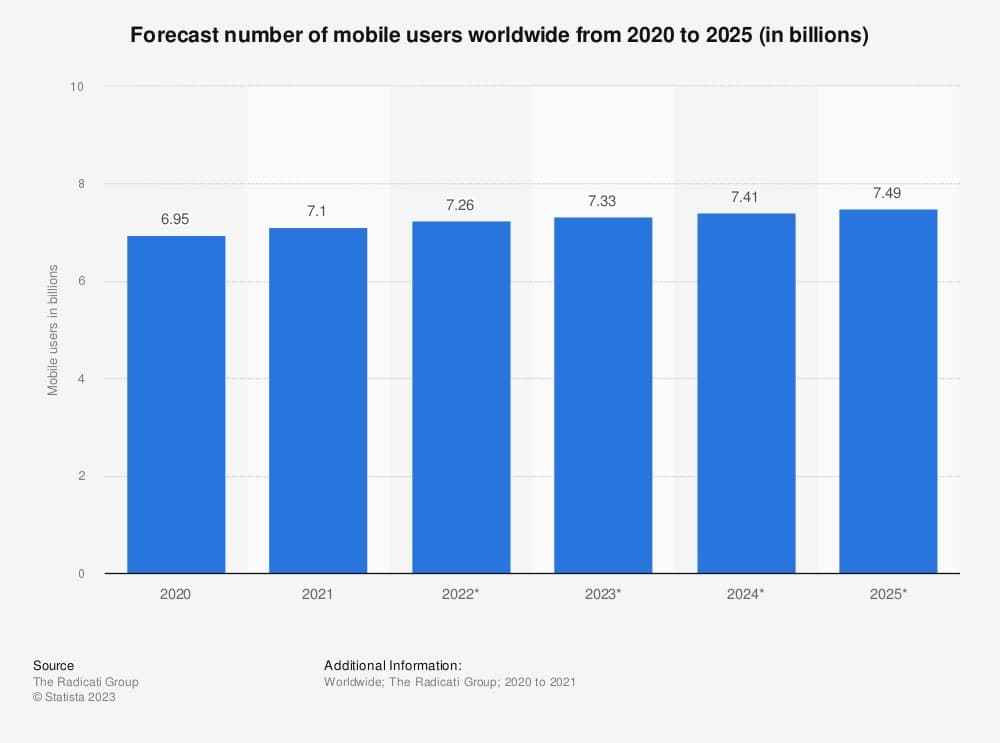
- – Google handles 3.5 billion searches daily and 1.2 trillion searches annually. It will remain the top search engine.
- – By 2023, Chrome will be the most-used browser with almost 64% market share. However, Safari (20%) is rapidly gaining adoption on mobile devices.
- – As of February 2023, there are 1.13 billion websites globally. Interestingly, 82% of them are deactivated, making only 200 million active websites.
- – WordPress powers over 43% of all websites and will likely exceed by 2024 as CMS adoption grows. Other popular platforms are Joomla, Drupal, Magento, Blogger, and Shopify.
- – As Internet infrastructure improves, video streaming will dramatically rise. Some estimates see 82% of all Internet traffic being video in 2023, which was 73% in 2017.
- – With online traffic increasing, Internet speed will become even more important globally by 2030. The average wifi speed is 91.6 Mbps in 2023.
2. Social Media
Since COVID, we have seen the usage of social media has grown rapidly. Now, real-time engagement and conversational commerce are crucial factors for businesses.
This means businesses must maintain a solid presence on social media platforms and post engaging content representing their brand.
Here are some critical stats businesses must know to reign supreme in the social media world.
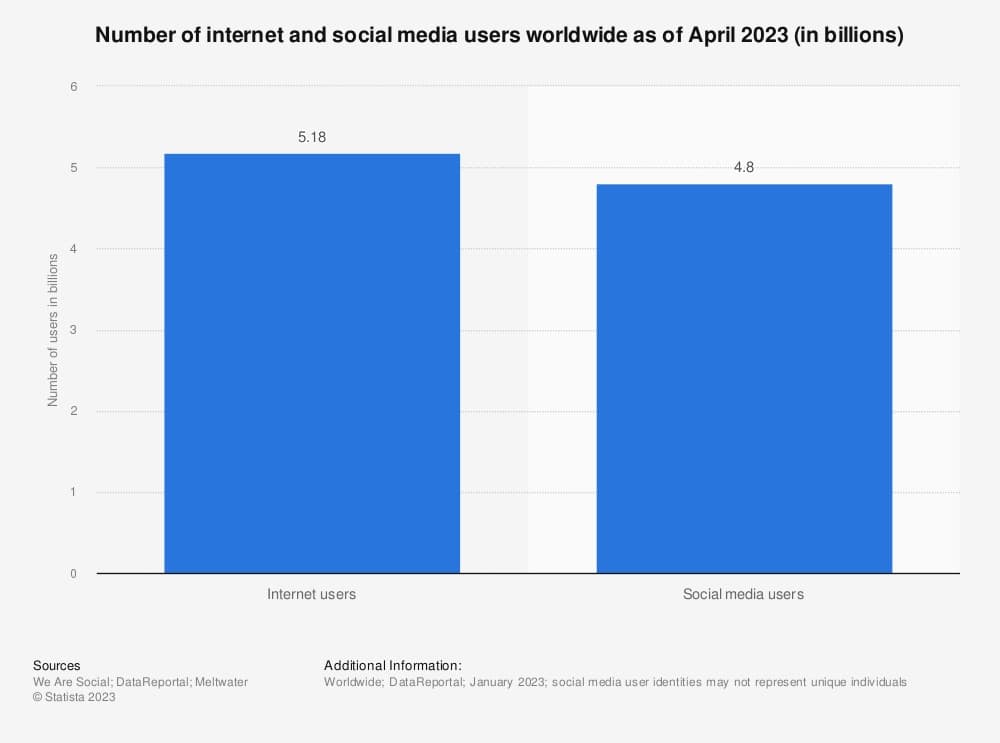
- – Social media usage is phenomenal, with over 4.8 billion users (59.9% of the global population) worldwide, with predictions to reach six billion by 2027.
- – Apps like Facebook, YouTube, and WhatsApp dominate now. But TikTok and Instagram will have 955 million and 1.44 billion active users by 2025.
- – Global daily social media usage averaged 151 minutes in 2022, up from 147 minutes in 2021. It shows people are spending more time on social media platforms each day.
- – Global social media use forecasts estimate an 18% increase in the penetration rate between 2024-2028, reaching over 75% by 2028 as adoption grows steadily worldwide.
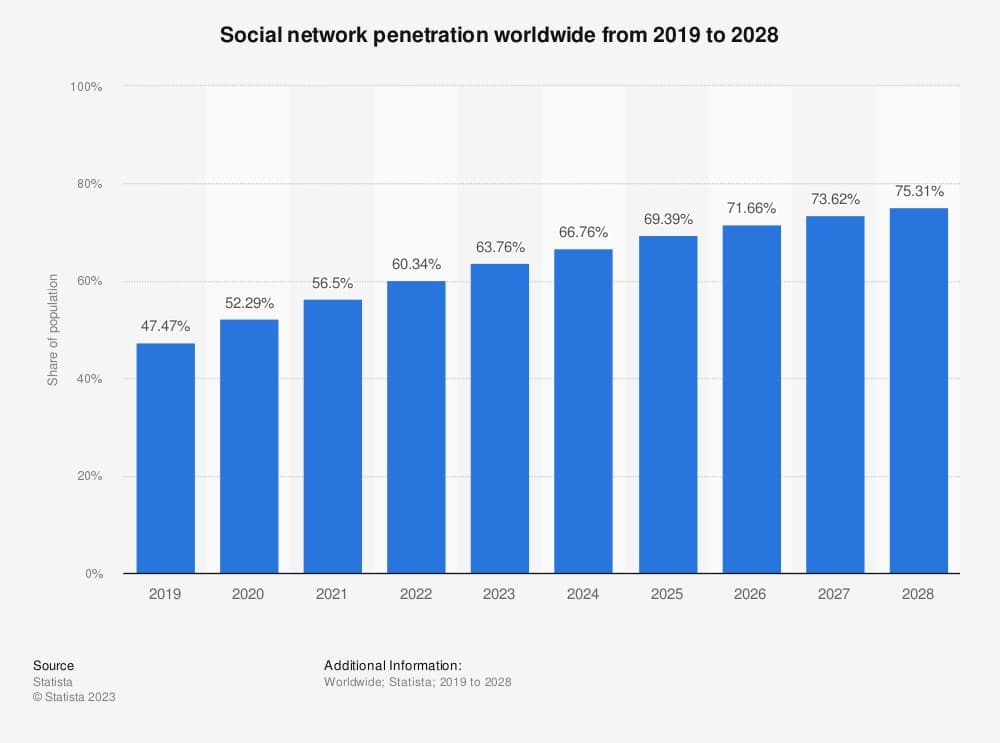
- – The top reason people use social media is to keep in touch with friends and family (47%), followed by filling their spare time (36.2%), reading news (36.2%), and posting about their lives (20%).
- – With almost 3 billion monthly active users and over a decade of growth, Facebook remains the most successful social network globally as of Q1 2023.
- – A 2023 survey found that over 50% of Instagram users enjoy funny posts, and 46% prefer creative content.
- – With 229 million users, India has the world’s largest Instagram audience as of January 2023, followed by the US at 143 million and Brazil at 113 million users.
- – Filipinos spend the most time on social media globally at nearly 4 hours daily, compared to just over 2 hours in the U.S.
- – Instagram reached 2 billion monthly active users in 11.2 years, following WhatsApp’s lead (11 years), with Facebook (13.3 years) and YouTube (14+ years) hitting the same milestone.
3. Content Marketing and Blogging
One of the key pillars of digital marketing is content marketing. Content marketing produces three times as many leads at a considerably lower cost than outbound marketing. In simple words, it is a cost-effective lead-generation technique.
90% of businesses have a content marketing strategy and proactively use blogging to build their brand and spread awareness.
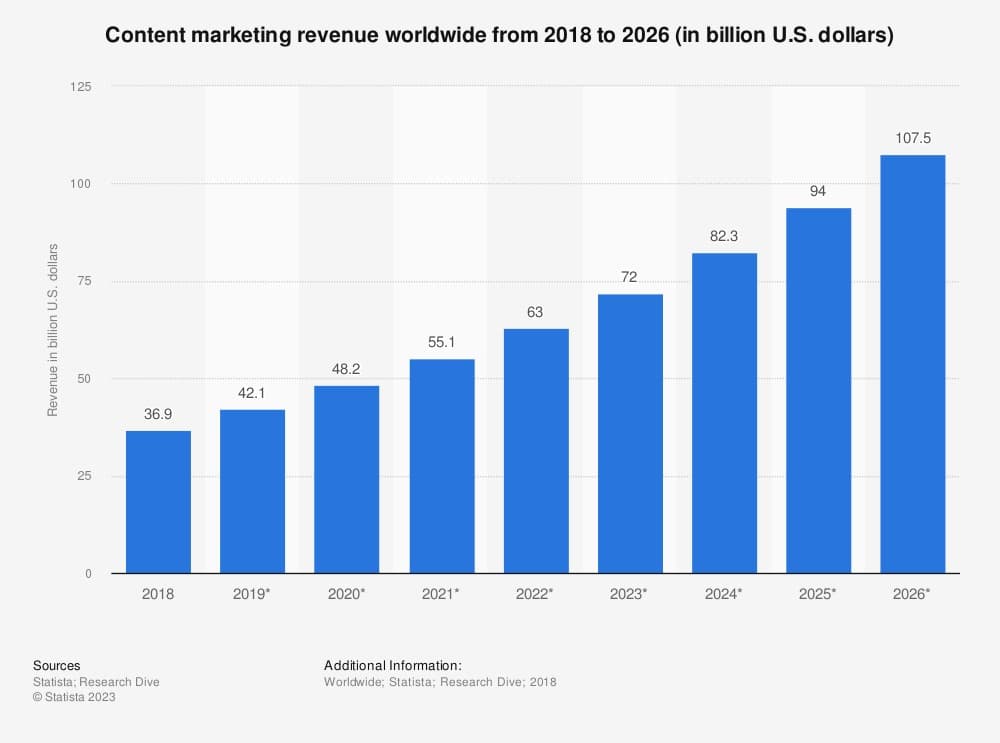
The following stats reveal businesses shouldn’t overlook polishing and improving their content marketing strategies.
- – By 2022, the content marketing revenue was $63 billion. It is expected to reach $107 billion by 2026.
- – In 2023, nearly half of marketers expected to raise their budgets for content marketing. Additionally, 80% of marketers worldwide thought their content strategy was highly successful.
- – Businesses know the value of blogging, so employing blogging is a content marketing approach for 48% of companies.
- – Content marketing generates 3x more leads than traditional marketing at 62% lower cost, leading to 6x more conversions.
- – In the last 12 months, 26% of B2C respondents stated their company has experienced extremely high or very substantial levels of success with content marketing.
- – WordPress is still the most popular blogging platform. Leading companies using WordPress include TechCrunch, TED, CNN, and the NFL.
- – In 2023, over 50% of B2C respondents said they used blogs, email newsletters, and email to their organization’s website to distribute content.
- – 36% of business marketers reported having centralized teams working on content marketing across their organizations.
- – The top three objectives that enterprise marketers claim content marketing helps them accomplish are brand awareness, audience education, and credibility/trust building.
- – Blogging builds trust and drives business. Companies with blogs get over 90% more links and see 13x higher ROI than those without.
4. Video Marketing
The popularity of video content is growing, and it is essential for increasing audience engagement and promoting brand visibility.
Businesses looking to draw in their online audience must fully grasp the potential of video marketing and how it affects their customer behavior.
91% of businesses now use video marketing in 2023. This marketing strategy has had a growth rate of 7% since 2016.
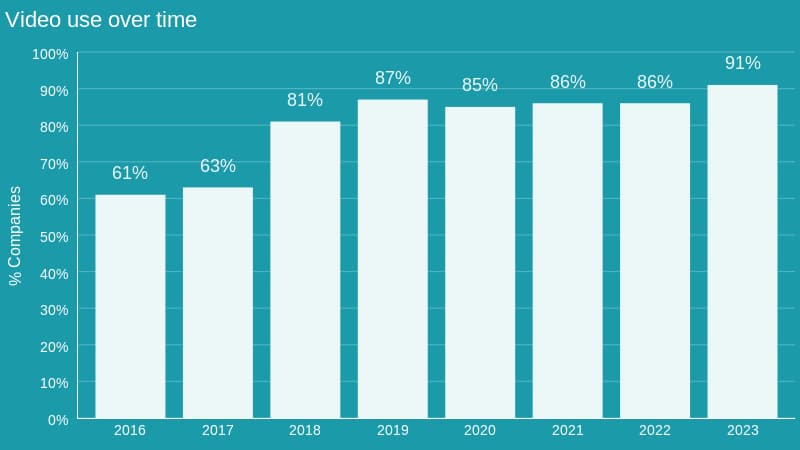
Learn how video marketing can be a boon in your marketing efforts with the following revealing stats. Hopping the bandwagon before it’s too late makes sense.
- – In 2021, $80 billion was spent on digital video advertising globally, expecting a surge of $120 billion by 2024.
- – Forecasts between 2024 and 2028 show an additional 263 million users (an increase of 30.29 percent) will use YouTube globally.
- – The amount spent on CTV advertising globally is anticipated to nearly double between 2022 and 2027. This is because many people are choosing Internet-connected gadgets over traditional linear TV.
- – Currently, the United States, China, and the United Kingdom are the three nations that spend the most on digital video advertisements.
- – According to the IAB, US digital video advertising spending rose 21% in 2022 to $47.1B. Also, it is expected to increase by another 17% to $55.2B in 2023.
With over 81 percent of all digital consumer engagement strategies, pre-produced video is marketing professionals’ most popular form in 2023.
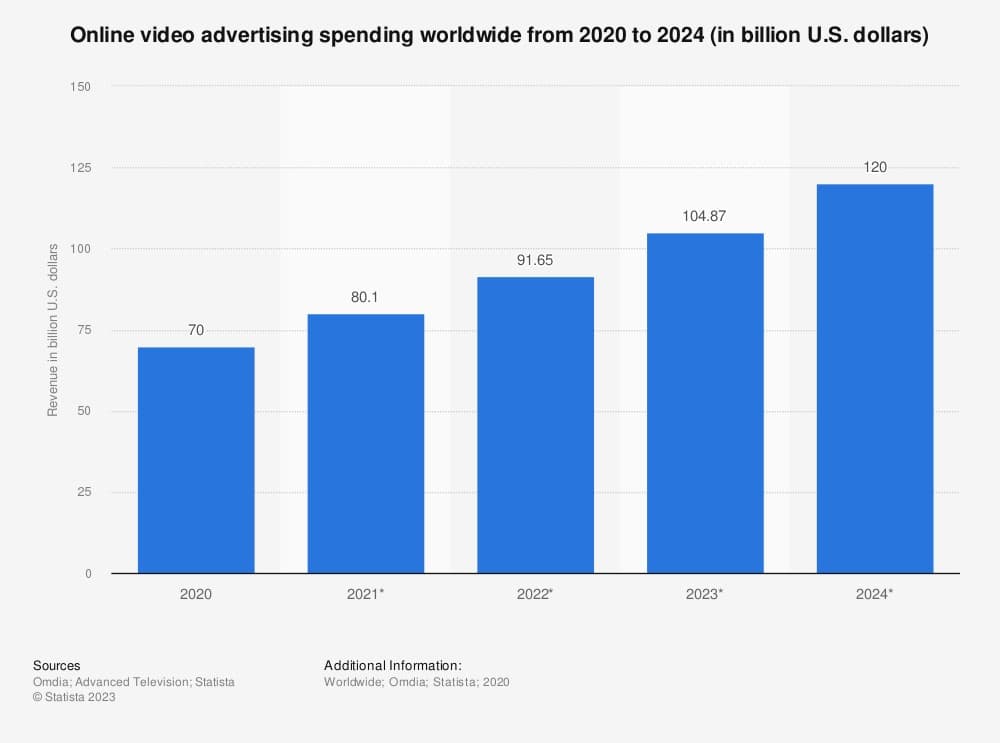
- – People spend about 6 minutes on pages with video compared to only 4.3 minutes on pages without video. It is 1.4x higher on pages containing video content than without video.
- – According to 56% of video marketers, leads and clicks are the metrics they use to assess the return on investment from their videos.
- – As expected, YouTube is the leading platform for video marketing with 90%, followed by Facebook (86%), Instagram (79%), and LinkedIn (79%).
5. Email Marketing
Email marketing is still a dependable and consistent tactic despite the emergence of new marketing methods. It still performs well for enterprises, with an ROI of 122%, which is outstanding considering it’s one of the oldest marketing techniques.
The number of emails being sent worldwide has been growing at a rate of 4.8% since 2017, with an estimated 392.5 million emails sent by 2026.
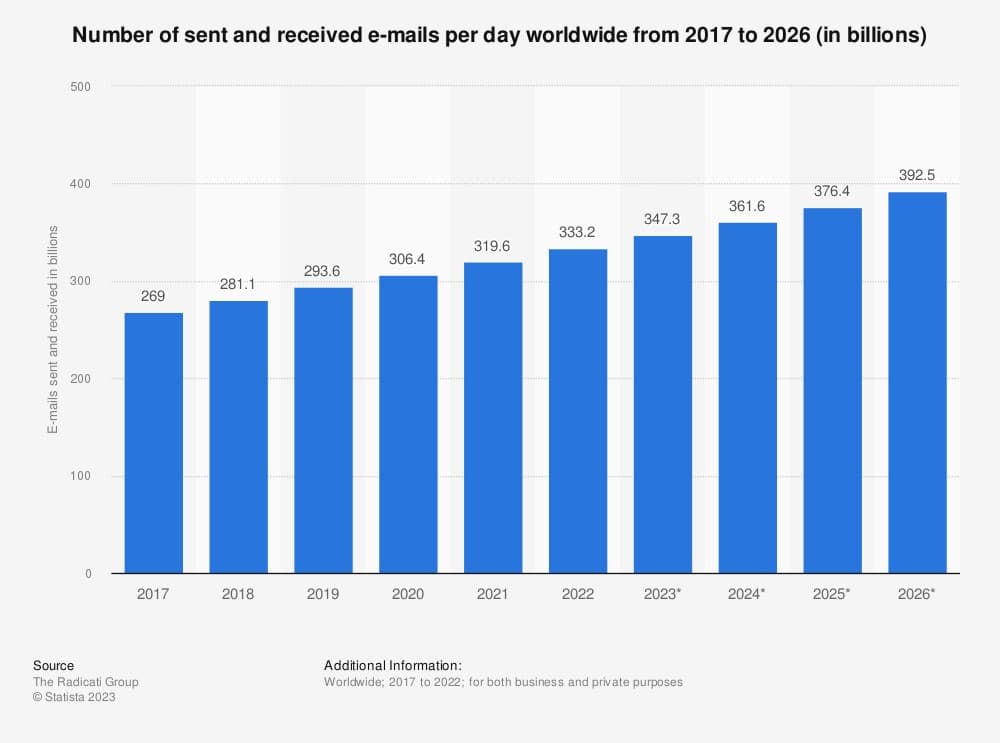
Email campaigns will remain a powerful tool for businesses of all sizes, enhancing communication with the target audience, driving conversions, and boosting sales.
Here are some eye-opening facts that reinforce the same.
- – The global email marketing market was valued at $7.5 billion in 2020 and is projected to reach $17.9 billion by 2027, growing at a 13.3% CAGR.
- – Daily global email traffic is massive and still growing – in 2022, there were 333.2 billion emails sent/received daily worldwide.
- – A 2022 US survey found that 25% of consumers are likely to purchase after receiving a newsletter email, showing they drive sales.
- – Despite new messaging apps, good old email continues growing – the global email audience will hit 4.6 billion by 2025, up 600 million users from 2020’s 4 billion.
- – Email newsletters are the most used marketing campaigns according to a 2022 global survey of marketers, with 88% sending newsletters versus 73% using promotional emails to connect with customers.
- – Another interesting survey suggests that 63% of marketers automate email over content and social, showing email’s precedence.
- – Financial service emails saw the highest click-to-open rate in 2022 at 16.68%, followed by publishing and communications at 14.47% and 11.83%. This shows financial content compels email engagement.
- – Email marketing aims to make products known and drive promotions per a global survey – 64% cited awareness and promos as key objectives, while 59% aimed to boost customer retention.
- – A 2023 survey showed that 51% of US, UK, and European email marketers find AI-supported approaches more effective than traditional email marketing, though 20% see no major difference in results.
6. Online Businesses
E-commerce is on its way to conquer the retail space and will foresee a staggering $8.1 trillion by 2026! However, getting engagement and conversions is tougher than ever as buyers do more research first. Reaching multiple decision-makers and getting responses feels harder every day.
We’ve compiled some of the most intriguing e-commerce and online business statistics and data available online. The key takeaway is clear: adopt e-commerce or get obsolete.
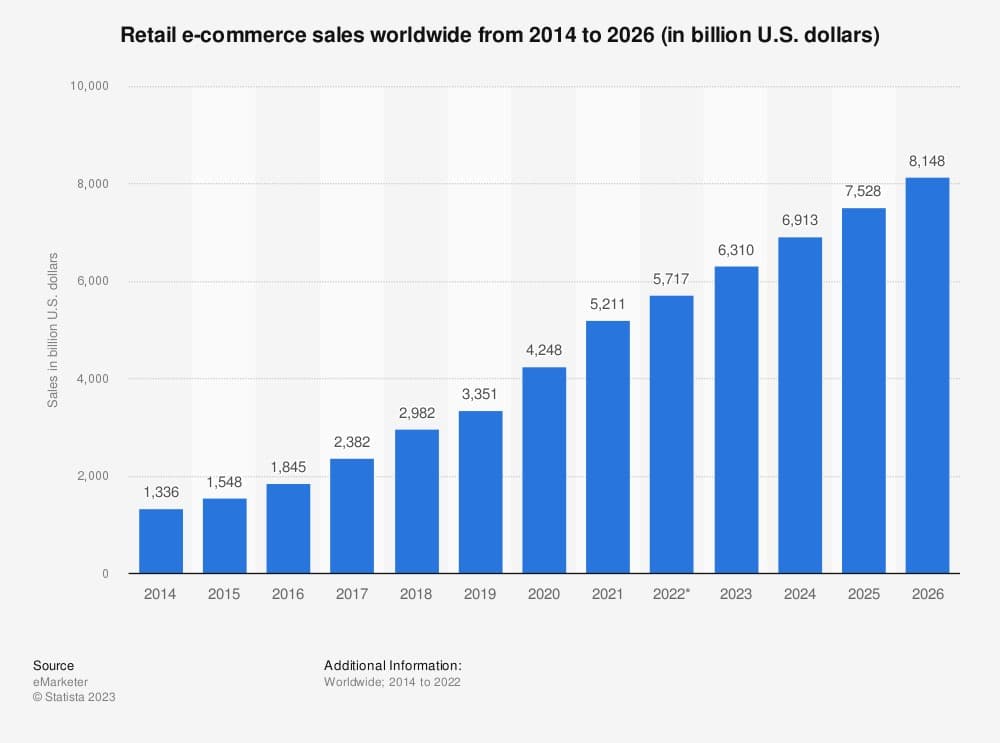
- – Businesses have realized the importance of online presence, so 71% have their own website. Even 35% of businesses think their operations need to be bigger to have a website.
- – Another interesting thing is that 81% of people research online before purchasing. Also, 66% see warranty information, and 52% see pricing.
- – Male singles spent more than female singles. Men spent $41,203 annually on average, while women spent $38,838.
- – It’s wild to think e-commerce could be 95% of all purchases by 2040! Men spend 68% more money online than women do.
- – 79% of business owners with a website expect to grow by 25% in revenue in the next three to five years.
- – Amazon (13.2% market share) dominates as an online shopping preference, especially with Millennials. Some other sites are eBay, Ali Express, etc.
- – Consumers put more weight on authentic reviews and testimonials from real users, and it drives more conversions, according to 96% of retailers.
- – Most customers (almost 90%) no longer believe in influencers. They are more likely to buy from brand accounts with real customer reviews.
- – Consumers are eager to purchase from companies that provide tailored digital experiences, according to 75% of respondents.
7. Lead Generation
Lead generation remains a huge priority for many online businesses. While we can use CRM tools to track leads, carving out time to build email lists can feel burdensome, especially for small businesses.
Getting prospects to respond and connecting with multiple decision-makers for B2B feels harder than ever. Standing out is tough, with only 2% of website visitors converting to leads on average.
Therefore, ad spending on social media has been increasing as well. Here are some of the stats businesses should be mindful of to steer the ship of their lead gen in the right direction.
- – Those multi-step WordPress lead gen forms can drive conversions way up, with some seeing 300% more conversions.
- – Word of mouth (92%), reviews, and media coverage (36%) drive buyer trust and purchases more than the company promises.
- – 50% of local mobile searches drive an in-store visit within a day. The opportunity to connect search to in-person is massive, especially as mobile keeps growing.
- – 25% of small businesses need to know their lead conversion rates. Tracking metrics is step one before identifying improvements.
- – Retaining customers requires less budget (almost five to seven percent) than acquiring new ones. Loyalty programs and incentives are worthwhile!
- – Email, social media, video, and content marketing will lead the way for lead generation in 2024. However, paid advertising is catching up, projected to account for $300 billion of lead generation spend by 2024.
- – The use of CRM software has increased to 91% of businesses(for companies with 11+ employees). By 2025, CRM revenues are projected to exceed $801 billion.
- – 1 out of 5 companies still use spreadsheets (Excel or Google Sheets) to store leads and data communication.
Source: WebAcquisition
See more: CES 2024: Largest audited global tech event - Poised for growth
See more: 10 ways MWC Las Vegas will supercharge your business’s potential
See more. Fxview powers traders and money managers with MAM/PAMM accounts


